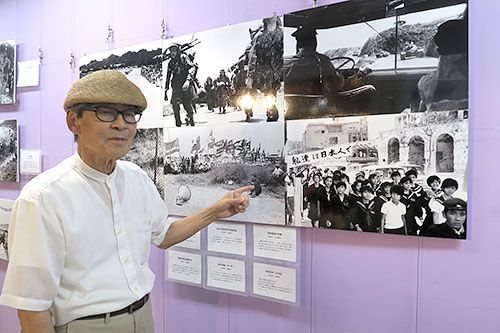Katsu Moriguchi holds photography exhibit on Okinawa under U.S. rule in Ginza: “I thought it would become a peaceful island, but…”

Katsu Moriguchi discussing his photography exhibit titled “Okinawa Under U.S. Rule: Memories of America-yu”, at the Washita Shop in Ginza, Tokyo
May 24, 2021 Ryukyu Shimpo
By Natsuko Yamakawa
(Tokyo) Journalist and former Ryukyu Shimpo reporter Katsu Moriguchi, age 83, of Chiba Prefecture, is holding a photography exhibit titled “Okinawa Under U.S. Rule: Memories of America-yu” at the Washita Shop in Ginza, Chuo Ward, Tokyo. The exhibit will be on display until May 31.
For more than half a century, since the 1950s, Moriguchi has reported on issues in Okinawa, and leads the “Okinawa wo kataru hitori no kai (one-person association for discussing Okinawa)”. The exhibit started on May 15, the anniversary of Okinawa’s return to Japan.
The exhibit includes 30 photographs, which include a photograph of children with carefree smiles taken in Itoman by Moriguchi at age 18, when he visited Okinawa in the spring of 1957, as well as photographs of a U.S. military tank driving imperiously down the winding roads of Nago (1960), Henoko/Kushibaru as the town scenery began to change after the U.S. military’s Camp Schwab and Camp Hansen were built (1957), priestesses of Kudakajima silently carrying out the August festival ceremony as U.S. military aircraft fly overhead (1963), and Self-Defense Force officer candidates standing on a stone gate of the Nakagusuku Castle ruins and studying the history of the Battle of Okinawa while looking at a strategy map for the Battle of Okinawa (1966).
“I thought that when Okinawa was returned, the bases would leave and it would become a peaceful island,” said Moriguchi. “The slogan was ‘kaku-nuki hondo-nami (free from nuclear weapons and equivalent to the mainland)’, but the U.S. military bases remained after reversion. In this exhibit, I presented just two photographs of the U.S. military after reversion. The burden of bases in Okinawa remains today no different from before reversion.”
(English translation by T&CT and Sandi Aritza)
Previous Article:“Who can we tell about our troubles?” Souvenir stores cry for help on a deserted Kokusai-dori
Next Article:Coral spawning on the same night as super moon lunar eclipse, alignment of ocean and cosmos
[Similar Articles]
- Former Ryukyu Shimpo cameraman publishes book to commemorate Koza Riot
- Ministry of Defense adds 10 installations in Okinawa to the drone no-fly zone list
- U.S. military to permit Okinawan people to pass through bases in case of Tsunami
- Sit-in protest in front of Camp Schwab marks its first year, reaches critical stage
- Former JSDF member calls sit-in at Camp Schwab a bulwark against militarism
 Webcam(Kokusai Street)
Webcam(Kokusai Street)


